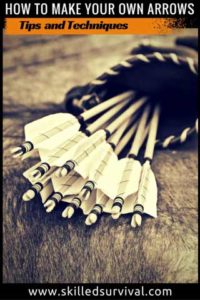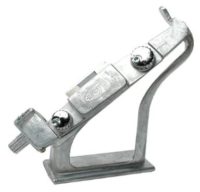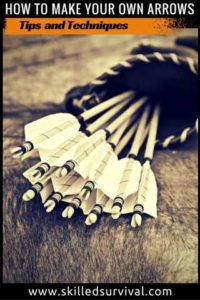
Why? Because it’s a major form of self-reliance.
And as survivalists, we love self-reliance.
Imagine pairing the power of learning – How To Make Your Own Arrows – with the skill of – How To Make A Longbow.
You’d never be an unarmed and helpless sap again.
No matter how bad our world becomes.
You can mold natural resources into a highly useful survival tool.
And not only a useful tool but a deadly one.
Whether your motivation to make your own arrows is focused on self-reliance, as a fun hobby, or to impress your friends, the following instructions will show you how to do it right.
Building Wood ARROWS – Start to Finish
But before making an arrow, we need to understand the basic parts that make up an arrow.
The good news is arrows are fairly simple devices and only include a few component parts.
So let’s go through them from tip to end.
Are You Ready For The Tough Times Ahead? Take My 60 Sec Quiz To See If You’re Part Of ‘The Fragile Masses’ Or Not… Start Quiz Now!
Basic Parts of An Arrow
The Arrowhead
At the leading tip of an arrow is the “arrowhead.”
This is the deadly sharp tip that does the real damage.
It can be skinny, broad, and normally made out of stone or metal.
But the good ones are razor-sharp and can penetrate deep into your intended target.
The Shaft
The next part of an arrow is the “shaft.” As the name implies, the long skinny part of the arrow attaches the arrowhead and the fletchings.
You can think of the arrow shaft as similar to the chassis of a car. It’s not sexy, but it holds everything together.
This leads us to part 3.
The Fletching
The fletching is the thin blades of feathers or plastic that are essential for controlling the arrow’s flight trajectory.
Without fletchings on the back of the shaft, your arrow will fly erratically and out of control.
Hitting a target without fletchings is a much more difficult task.
The Nock
Lastly is the nock. The nock is a small “notch” at the base of the arrow where the bowstring and the arrow meet. A proper notch is essential for the bowstring to fire the arrow.
Without a notch at the arrow’s back end, the bowstring release would not completely transfer to the arrow.
The bottom line is:
The notch is critical for bow and arrow performance.
As A Way To Introduce You To Skilled Survival, We’re Giving Away Our #78 Item Complete Prepper Checklist. Click Here To Get Your FREE Copy Of It.
How To Make Your Own Arrows
The process of making arrows can be broken down into making the component parts and then assembling those parts.
So I will start with arrowheads, end with the nock, and then wrap up with how to assemble the entire thing.
How To Make Your Own Arrowheads
Getting the arrowhead right is essential to building a good arrow.
You can make your own arrowheads out of many raw products. Stone, rebar, porcelain, or even glass can become an arrowhead.
As long as the arrowhead has balance and is sharp as hell.
Here are the basic steps in making your own arrowheads:
- Using a hammer or stone, break pieces of Flint, Slate, Obsidian, or Chert into roughly triangular pieces – no longer than 2 inches and no wider than 1 inch.
- Trimming and shaping the arrowheads is accomplished through a process called “Flint Knapping.” To do this, strike lightly against the edges with a nail or screwdriver to produce jagged, sharper edges. This produces strong edges.
- The next part is aptly called “Grinding” because you use a stone or sandpaper to grind away the edge until it is razor-sharp. This weakens the edges that will wear down with use, but the edges are not as important as the point. So I wouldn’t worry too much.
- Finally, chip away a couple of indents at the bottom of the arrowhead for fastening to the shaft. This can be achieved using the bolt or screw to sand away the stone to create perfect little half-circle indents.
If an image is worth 1000 words, a video is better. So let’s walk through a few excellent how-to videos on arrow making.
How to make an obsidian arrowhead for primitive archery
How to Make a Forged Steel Bodkin Arrowhead From Rebar
Making an arrowhead out of Toilet Porcelain
Now you may be wondering, “are these handmade arrowheads as good as expensive store-bought broadheads?”
Well, then, you should check out this test video:
Part 1: Glass Arrowhead vs. Modern Broadhead – Gel Penetration Test
It looks like the handmade glass arrowhead held its own.
But you must be patient and practice your arrowhead-making skills to get similar results.
If you are unwilling to invest the time and energy, buy some good broadheads online and attach them to your arrow shafts.
As A Way To Introduce You To Skilled Survival, We’re Giving Away Our #78 Item Complete Prepper Checklist. Click Here To Get Your FREE Copy Of It.
How To Make Your Own Arrow Shafts
Arrow shafts are typically made of wood or lightweight plastics.
Because these are materials you can machine and mold but are still strong enough for our purposes.
The key to making good arrow shafts is balance and symmetry. When you’re done, you want it to be perfectly round.
The good news is that the DIY arrow shaft process is the same regardless of the material chosen.
Selecting Your Arrow Shaft Material
With wood, you want to find a slab with very few imperfections. So a limited number of knots or warping.
Now take your raw slab of lumber and cut it into as many square pieces as possible.
Cut them to your desired overall length.
Here’s a video on selecting arrow shaft wood and initial cuts:
Arrow shafts from lumber
Arrow Shaft Making Jigs
Once you have your square cut shafts, you must round them into dowels (arrow shafts). You can do this via several different methods (see the following videos), but the basic process is the same.
First, feed the square shafts through a router, saw blade, chisel, or sharpener while rotating the square shaft. You create the rotating motion with a drill.
This rotating and feeding process creates your perfectly round arrow shafts.
Here are 4 videos detailing several unique arrow shaft-making jigs.
1Simple Dowel Making Jig For The Table Saw
2Making Arrow Shafts With The Veritas Dowel Maker
Old School Dowel Making Jig
4How To Make Your Own Arrow Shafts With A Shotting Board
Fine Tuning Your Arrow Shafts
Now use your drill to rotate the shaft in a piece of sandpaper quickly. This helps to smooth the arrow shaft and fine-tune its symmetry.
Finally, use an arrow spinner to test your shaft.
An arrow spinner will give you visual feedback on how straight and balanced your arrow shaft is.
Keep sanding and testing until it spins smoothly on your arrow spinner.
You can either purchase a good arrow spinner or make your own (see the video below).
DIY Arrow Spinner: How To Make Your Own Arrow Spinner
How To Make Your Own Fletchings
It’s important to get your arrow’s fletchings right. They are essential to keep your arrow flying straight.
Before you can add fletchings, you must choose your fletching material.
Traditionally, bird feathers have been used as fletchings. But feathers are not the only material available. You can also use duct tape.
Make Duct Tape Fletchings
Regardless of the material you choose. The best way to apply a fletching in the proper location and orientation is to use a fletching jig.
This device will help you get the critical fletching application right. Here’s h
What about those of us who are hardcore DIYers? Then make your own fletching jig.
How To Make A Homemade Fletching Jig
Adding The Nock
The nock is simply a slit at the end of the arrow shaft, right? Well, technically, yes, but there’s more to it than that.
For example, watch the next video to see how to properly add a nock at the end of your arrow shafts using only hand tools.
Self-Cut Nocks In Wood Shaft Arrows
You also might want to add some horn inserts for your self-nocked arrows. This help to strengthen your nock and prevents the ends from splitting after heavy use.
Remember, this is where your bowstring and arrow touch, and so it’s the location on the arrow shaft that will take the most force during the energy transfer.
As A Way To Introduce You To Skilled Survival, We’re Giving Away Our #78 Item Complete Prepper Checklist. Click Here To Get Your FREE Copy Of It.
Horn Insets for Self-Nocked Arrows
Finally, you may want to purchase nocks online and then fit them over your wooden arrow shafts.
It’s faster and easier; you’ll need to taper the end of the shaft to allow the nocks to fit onto the shaft.
How to use the Deluxe metal Taper Tool
Putting It All Together
So now you have all the basic steps to making your own arrows, but now you must put it all together.
Here’s a series of videos that show you one way to make your own arrows from start to finish.
Part 1. How To Make Your Own Arrows
Part 2. How To Make Your Own Arrows
Part 3. How To Make Your Own Arrows
Final Thoughts
You now have all the knowledge to start making your own arrows. However, if this is all new to you, then you don’t yet have all the skills.
And the only way to acquire those is to take meaningful action.
To find some raw wood, cut it into square sections, feed it through a shaft jig, make an arrowhead, add fletchings and nocks, and try it.
That’s how to make your own arrows today.
Will Brendza
P.s. Are you ready for the tough times ahead?
Find out now by taking my short Readiness Score Quiz – it’s absolutely free.
Once complete, you’ll know exactly where you stand on the “fragile” vs.” resilient” spectrum.
So click here to start the Quiz….And don’t worry; the questions are so easy a 3rd grader could answer them.
Click on the image to begin the Quiz and find out once and for all if you’re part of “The Fragile Masses” or “The Resilient Few.”
Top Image Source
The post How To Make Your Own Arrows: Tips, Tricks, & Techniques appeared first on Skilled Survival.







